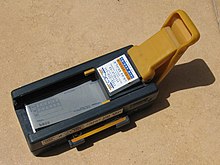
A credit card imprinter, colloquially known as a ZipZap machine, click-clack machine or Knuckle Buster, is a manual device that was used by merchants to record credit card transactions before the advent of payment terminals. [1]
The device works by placing the customer’s credit card into a bed in the machine, then layering carbon paper forms over the card. A bar is slid back and forth over the paper to create an impression of the embossed card data and the merchant information on the imprinter. The customer signs these paper forms, with one copy as the customer receipt and the other kept by the merchant. [2]
History

These devices were used from the advent of payment cards in the 1960 until the 1980s-1990s when electronic payment terminals started to replace them. However they continued to be used well into the 2000s for places where network access was difficult, such as mobile locations like taxis and airplanes, or as a backup system in case of payment terminal failure.
See also
References
- ^ "Knuckle Buster". Investopedia. Retrieved 2021-09-15.
- ^ "What Is a Credit Card Imprinter?". Business.com. 2017-12-07.